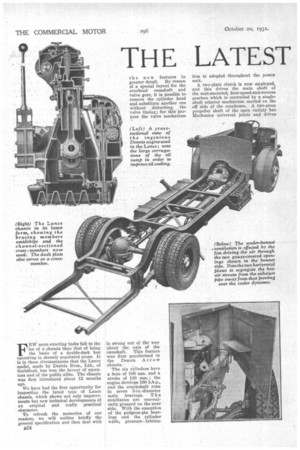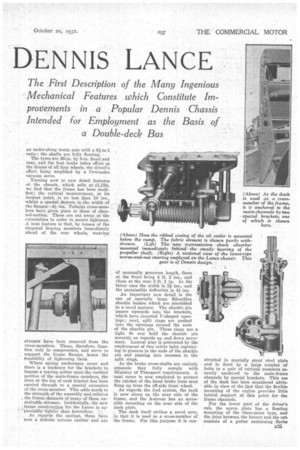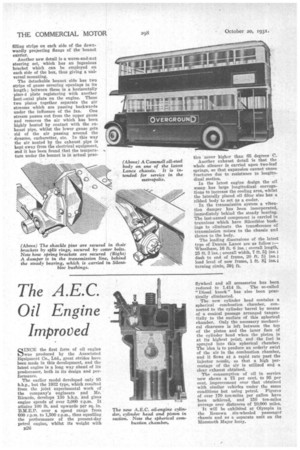TH E LATEST
Page 42

Page 43

Page 44

If you've noticed an error in this article please click here to report it so we can fix it.
DENNIS LANCE
FEW more exacting tasks fall to the lot of a chassis than that of being the basis of a double-deck bus operating in densely populated areas. It is in these circumstances that the Lance model, made by Dennis Bros., Ltd., of Guildford, has won the favour of operators and of the public alike. The chassis was first introduced about 12 months ago.
We have had the first opportunity for inspecting the latest type of Lance chassis, which shows not only improvements but new technical developments of an original and really practical character.
To refresh the memories of our readers, we will outline briefly the general specification and then deal with D24 the new features in greater detail. By reason of a special layout for the overhead camshaft and valve gear, it is possible to remove the cylinder head and substitute another one without disturbing the valve timing; for this purpose the valve mechanism is swung out of the way about the axis of the camshaft. This feature was first popularized in the Dennis Arrow chassis..
The six cylinders have a bore of 100 mm. and a stroke of 130 mm.; the engine develops 100 b.h.p., and the crankshaft runs in seven 3-in-diameter main bearings. The auxiliaries are conveniently grouped on the near side. With the exception of the gudgeon-pin bearings and the cylinder walls, pressure luhrica
thin is adopted throughout the power unit.
A two-plate clutch is now employed, and this drives the main shaft of the unit-mounted, four-speed-and-reverse gearbox which is controlled by a singleshaft selector mechanism carried on the off side of the crankcase. A two-piece propeller shaft of the open variety has Mechanics universal joints and drives an under-slung, worm axle with a 61-to-1 • ratio ; the shafts are fully floating. . The tyres are 36-in. by 8-in, front and rear, and the foot brake takes effect in the drums' of all four wheels, the driver's effort being amplified by• a Devvandre vacuum servo.
Turning now to new detail features of the chassis, which sells at £1,150, we find that the frame has been modified ; the vertical measurement, at its deepest point, is no less than 10 ins., whilst a special. feature is the width of the flanges—ft ins. Tubular cross-members have given place to those of channel-section. These are cut away at the extremities in order to secure lightness. A neat feature is that, by reason of the diagonal bracing members immediately ahead of the rear wheels, weaving stresses have been removed from the cross-members. These, therefore, function only in compression, and serve to support the . frame flanges, hence the feasibility of lightening theni.
.Where. spring anchorages occur and there is a tendency for the brackets, to impose a tearing action upon the vertical portion of the main-frame members, the rivet at the top of each bracket.has been carried through to a special extension of the cross-member. This adds much to the strength of the assembly and relieves , the frame, channels of many•of tb.ese undesirable stresses. Incidentally, the new .; frame construction for the Lance is ap
preciably' lighter than heretofore. , As Jegards the springs, these have now a definite reverse camber and are
of unusually generous length, those at the front being 4 ft. 2 ins., and those at the rear 5 ft. 1 in. In the latter ease the width is 3i ins.,-and the permissible deflection is 41 ins.
An important new detail is the use of specially large Silentbloc shackle bushes which are assembled in a novel manner. The shackle pin passes upwards into the brackets, -which have inverted IT-shaped openings ; next, split rings are pushed into the openings around the ends of the shackle pin. These rings are a tight fit and hold the shackle pin securely as regnrds up and down move' rnent. Lateral play is prevented by the employment of two cotter bolts registering in grooves in the ends of the shackle pin and passing into recesses in the split rings.
As the brake cross-shafts are entirely separate they fully comply with Ministry of Transport requirements. A neat cover is now employed to protect the ratchet of the hand brake from mud flung up from the off-side front wheel.
As regards the fuel system, the tank is now slung on the near side of the frame, and the Autovac has an accessible mounting on the near side of the dash plate.
The dash itself strikes a novel note, in that it is used as a cross-member of the frame. For this purpose it is con structed in specially stout steel plate and is fixed by a large number of bolts to a pair of vertical members securely anchored to the main-frame channels by special brackets. This use of the dash has been considered advisable in view of the fact that the flexible mounting of the engine provides little lateral support at this paint for the frame channels.
For the lower part of the driver's cab, the apron plate has a floating mounting of the three-point type, and the joint between the bonnet and the cab consists of a gutter containing Sorbo
filling stripe on each side of the downwardly projecting flange of the bonnet carrier.
Another new detail is a worm-and-nut steering set, which has an ingenious bracket which can be employed on each side of the box, thus giving a universal mounting.
The detachable bonnet side has two strips of gauze covering openings in its length ; between these is a horizontally place d plate registering with another horiamtal plate on the engine. These two plates together separate the air streams which are passing backwards under the influence of the fan. One stream passes out from the upper gauze and removes the air which has been highly heated by contact with the exhaust pipe, whilst the lower gauze gets rid of the air passing around the dynamo, carburetter, etc. In this way the air heated by the exhaust pipe is kept away from the electrical equipment, grnd it has been found, that the temperature under the bonnet is in actual prac tice never higher than 65 degrees C. Another exhaust detail is that the whole silencer is carried upon two-leaf springs, so that expansion cannot cause fractures due to resistance to longitudinal motion.
In the latest engine design the oil sump has large longitudinal corrugations to increase the cooling area, whilst the laterally placed oil filter also has a ribbed body to act as a cooler. In the transmission system a vibration damper has been incorporated, immediately behind the steady bearing. The last-named component is carried in trunnions which have Silentbloc bushings to eliminate the transference of transmission noises to the chassis and thence to the body.
The leading dimensions of the latest type of Dennis Lance are as follow :— Wheelbase, 16 ft. 6 ins.; overall length, 25 ft. 3 ins.; overall width, 7 ft. 51 ins.; dash to end of frame, 20 ft. 3+ ins.; load level of new frame, 1 ft. Si ins.; turning circle, 59i ft.




































































































